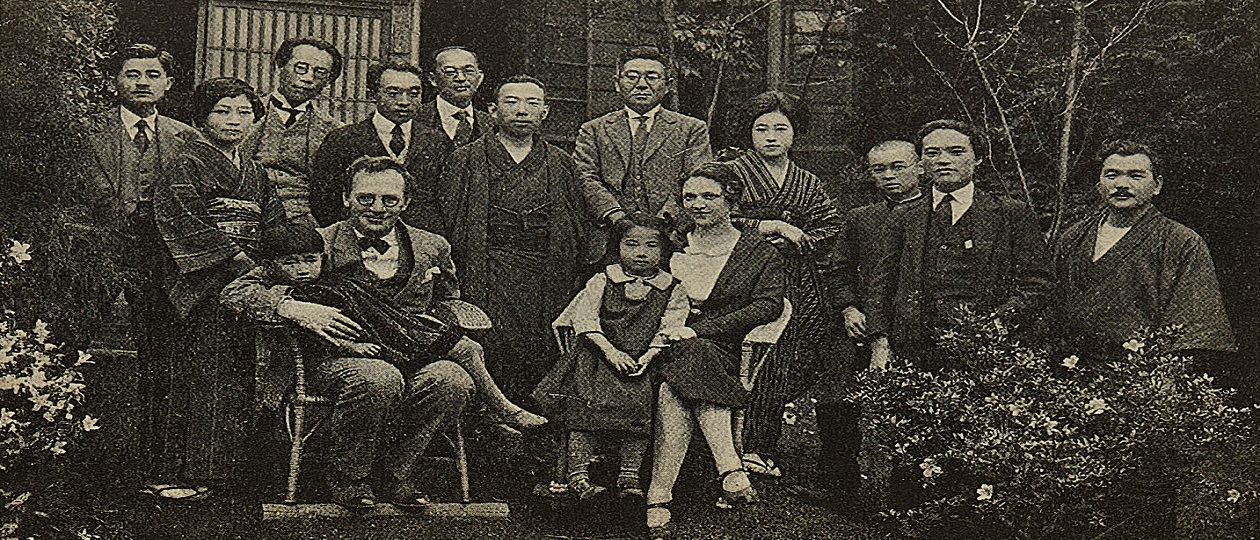
December 1945. Japan. The war has just ended. In the center of Tokyo, in the half-destroyed building of the Yurakuza Theater, the first post-war premiere is Chekhov’s The Cherry Orchard.
The play was last shown in 1937. Then it was directed by Aoyama Sugisaku, who 8 years later would return to Chekhov again, gathering all the stars of Japanese Shingeki for the production.
“Our beloved Chekhov has returned to Japan again!” — theater critic Ando Tsuruo will write after the premiere in the newspaper Tokyo Shimbun.
In the post-war period, scenes from The Cherry Orchard were literally played out all over Japan. At the end of 1945, the government began land reform. After the war, the country lost a significant part of its land, the area of the state decreased, and the cultivated area also decreased. The government was supposed to buy the land from the largest landowners and then sell it to the peasants at predetermined prices.
Director Hijikata Yoshi, in a review in the Asahi newspaper, noting the topicality of the production, wrote: “Now in many wealthy homes in Japan, in connection with the introduction of the land law, many tragicomic scenes are being played out. People work, talk about land ownership, about the impoverishment of landowners and the growth of the influence of capitalists. This is what I felt first of all when I watched the premiere of “The Cherry Orchard” in the packed Yurakuza Theater.”
The first post-war “Cherry Orchard” almost 8 years later, it seems, was symbolic. A few months before that, Japan accepted the terms of the Potsdam Declaration and signed the act of unconditional surrender. Japanese militarism, the first shoots of which began to sprout back in the Meiji era, was uprooted. Old Japan retreated, though without destroying the cherry orchard, but with the destruction of Hiroshima and Nagasaki. In 1947, the Post-War Constitution was adopted, including Article 9, which prohibited Japan from having armed forces and participating in the war.
The Meiji era transformed Japan from an agrarian country into a state that was building up its militaristic power.
The Meiji era opened Japan to foreigners.
The Meiji era introduced the Japanese to Chekhov.
Japan’s meeting with Chekhov was not loud. Much later, literary scholar and writer Jinzai Kiyoshi compared Chekhov’s influence on Japanese literature to raindrops that gradually soak the soil.
Chekhov’s works appeared during the revolutionary Meiji period, when the country was on the path of radical transformation, but in the Japanese manner. Therefore, literature, as researcher Kim Ryoho writes, needed a “radical renewal of the creative method.” Japanese writers began to actively turn to the experience of foreign colleagues, studying not only European classics, but also Russian literature.
Japan’s first acquaintance with Chekhov was at the beginning of the 20th century thanks to Senuma Kayo. Her parents were parishioners of the Orthodox Church, and Kayo herself studied at a girls’ theological boarding school. After graduating, she stayed there to teach. At that time, Kayo became acquainted with translated Russian literature.
During the Meiji period, translations of works by Russian writers — Tolstoy, Gorky, Dostoevsky — were made from English. But Kayo liked Russian literature so much that she decided to read it in the original. In 1896, Archbishop Nikolai of Japan gave her textbooks from which she learned Russian.
Perhaps Kayo first became acquainted with Chekhov’s works at the St. Nicholas Theological Seminary at the Resurrection Cathedral in Tokyo. Since Kayo knew Russian, she was able to translate fiction books that were regularly donated to the seminary from Russia. Among these books was the Complete Works of Chekhov, edited and corrected by the author himself.
In 1903, in the August issue of the Shin Shosetsu magazine, Kayo published the first translation of Chekhov. It was Summer Residents. In 1908, the first Collection of Masterpieces of the Outstanding Russian Writer Chekhov was published in Japan in Senuma Kayo’s translation. In a review of Kayo’s work in the Teikoku Bungaku magazine, they wrote: “A gifted woman has outpaced men in introducing readers to the work of an outstanding writer of Eastern Europe. I would like to draw the attention of our experienced writers to this.”
By 1913, Kayo had translated 26 works by Chekhov — 22 short stories and novellas and 4 plays. Kayo died in 1915. She even traveled around Russia several times, translating Kuprin, Gorky, and Dostoevsky. Kayo’s work was highly appreciated in the USSR 30 years after her death. Orientalist and translator Nikolai Konrad wrote: “The historian of both Japanese and Russian literature should name the translator who did the main work of introducing Chekhov to Japanese soil. This is Senuma Kayo.” Kayo introduced Chekhov to the Japanese.
Famous translators and writers began to translate stories and plays — Masamune Hakucho, Osanai Kaoru, Nobori Shomu, Satomi Ton, Nagatsuka Takashi, and Toki Aika.
Chekhov’s popularity in Japan during the Meiji period was not only due to the work of Senuma Kayo. The critic Kakuta Kokokakyaku (pseudonym: Kennan) wrote about Chekhov’s contemplative nature in his article “Study of Russian Literature and Anton Chekhov”, published on March 6, 1904, in the supplement to the Sunday issue of the newspaper “Yomiuri”. Kennan contrasted him with Tolstoy and Gorky, as artists of active action. He also compared all three writers with the great thinkers of ancient China: Tolstoy with Confucius and Mencius, Gorky with Han Fei-tzu, Chekhov with Zhuangzi.
Kennan associated Chekhov’s worldview with Eastern contemplation and passivity. He noted that Chekhov rises above the vanity of things, seemingly seeking the natural state and truth of reality.
Chekhov was close to the Japanese. He had in common with them the textbook principle of “brevity is the sister of talent”, which is also the idea of Japanese art. Chekhov is very specific and extremely clear, but all his specifics are built from details. This makes his texts related to haiku poetry, in which the author catches one single specific moment, as if tearing a frame from the film of reality. The universe of a poem in the text of Japanese poetry is also built thanks to details — for example, in Basho:
“On a bare branch
A raven sits alone.
Autumn evening.”
The text is built on specific details that give rise to sensations and meanings, taken out, as if in brackets. Perhaps this is why the Japanese understand Chekhov’s laconicism more than Tolstoy’s monumentalism. Chekhov placed the entire Universe in a short story or play, leaving “a lot of air”, bringing all the most tragic, vivid events offstage. The viewer/reader learns about what happened through details. This probably makes him similar to Japanese sumi-e (ink painting) artists who create a picture by drawing only the most necessary lines. At the same time, most of the work is taken up by white empty space (the “yohaku” effect).
Despite the specifics, Chekhov leaves the reader alone with the unsaid, which gives rise to a subtle feeling of “after-feeling”, which in Japanese is called “yojo”. “Yojo”, like other categories of Japanese aesthetics such as “yugen”, “shibui” and “iki”, is something that is very difficult to capture. “Yojo” is the “aftertaste” of the work, a kind of subtext, something unexpressed and barely perceptible. This is the ultimate concentration of beauty in a compressed form. Chekhov, like Japanese poets, is not carried away by detailed descriptions and additional details. He understands that he will not be able to tell everything, so he breaks off the narrative, falling silent. Leaving the reader alone with the emptiness of the pause.
Japanese painters believe that “the empty spaces on the scroll are filled with more meaning than what the brush has written on it.” So the “empty spaces” of Chekhov’s finales seem to open up more space for “speculation”, giving rise to variability.
It is believed that Chekhov is very difficult to stage, because the paper text resists unambiguous theatricalization, and the finale gives rise to many interpretations, since “in Chekhov’s dramaturgy there is a need to speculate it by the will of the future embodier”. Perhaps that is why Nemirovich-Danchenko believed that “any play by Chekhov should be staged anew every time”. But there is another point of view: Chekhov is not complex, Chekhov is very subtle, delicate. There are meanings hidden behind the details, which Chekhov does not try to show to everyone at once. It is like ripples on water. A subtle feeling, similar to “yugen”, i.e. hidden beauty.
The Japanese did not seem to be intimidated by this complexity. On the contrary, they seemed to sense this subtlety of Chekhov. His plays were loved in Japan. Sato Seiro believes that the secret is that Chekhov’s drama develops in the soul itself. The characters’ deep reflections are also consonant with the Japanese worldview. Seiro points out that in the moments marked by “silence” and “pause” in the plays, a connection with eternity is felt. The pauses seem to embody the spirit of Zen Buddhism, in which “there is everything in the “no”.
This is clearly felt in the second act of “The Cherry Orchard”, when the string breaks. The characters sit thoughtfully, in silence. Firs mutters quietly and suddenly… “A distant sound is heard, as if from the sky, the sound of a broken string, dying away.” It is this moment, as Seiro writes, that connects the moment with eternity.
All of Chekhov’s plays are very structured and academic. The world of his plays is logical and orderly. This resembles a model of the ideal Universe, which, for example, tea masters created in their pavilions. Chekhov has no chaos of objects, details and actions: everything is in its place, everything is subject to strict logic, everything has its time. Tea pavilions are organized according to the same principle, where there is nothing superfluous, and each object is as utilitarian as possible.
Chekhov’s works, especially “The Cherry Orchard”, had a huge influence on Japanese writers. It is not surprising, because the play was published in Japanese 11 times in eight different translations between 1949 and 1955.
Chekhov was not only staged, but also borrowed. The concept of plagiarism (as we understand it) cannot be applied to classical Japanese literature, since borrowing other people’s pieces of text or plots was considered normal. This practice seemed to pay homage to the original source, and also created an element of co-creation, for example, in poetry, when Soseki quoted Buson.
Chekhov was also “borrowed”. The classic of Japanese literature Dazai Osamu repeatedly mentions Chekhov’s name and his characters. And Akutagawa Ryunosuke creates a short story “The Garden”, consonant with Chekhov’s “The Cherry Orchard”. In both cases, the garden perishes — a symbol of the passing era…
To this day, Chekhov, along with Tolstoy and Dostoevsky, remains a pillar of “Russian classics” in Japan. Chekhov is staged, Chekhov is loved, haiku are dedicated to Chekhov.
In the book “My Chekhov”, Asahi Suehiko wrote:
November Night.
I read Anton Chekhov.
I am speechless with amazement.
And “The Day of Chekhov’s Death” (“chehofu ki” /チエホフ忌) — July 15 — is used in poetry as a summer seasonal word (kigo). A seasonal word (kigo) is a word or expression that indicates the time of year to which the picture depicted in the hokku/haiku belongs.
I see the light,
Lighting a cigarette from a candle —
Today Chekhov died…
(author Nakamura Kusato)
Kigo help to feel the environment or the created image more fully, more clearly. And, at the same time, unobtrusively, as if by hint. “Chehofu ki” is a summer night after the sultry heat. It is interesting that the day of the death of the writer, whose creative style was distinguished by the fullness of small details, itself became a kigo detail, giving birth to a number of images.
The writer, Nobel Prize winner Kawabata Yasunari wrote in “Study of the Thunderstorm”: “Chekhov has something oriental, the sweet-bitter taste of his works resembles the traditional Japanese attitude to non-existence.”
Perhaps, in Chekhov’s works the Japanese really hear that very “mu”, which can be called the fullness of Being. And behind the closed curtain after another production of “The Cherry Orchard”, it seems that an endless field of interpretations opens up.





